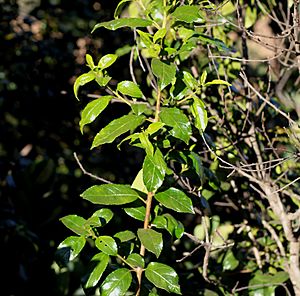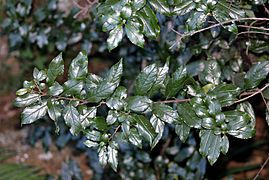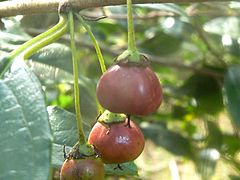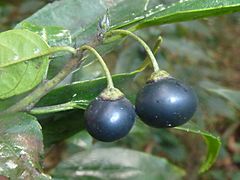Shiny-leaf buckthorn facts for kids
Quick facts for kids Shiny-leaf buckthorn |
|
|---|---|
 |
|
| A shiny-leaf buckthorn plant | |
| Scientific classification | |
| Genus: |
Rhamnus
|
| Species: |
prinoides
|
| Synonyms | |
|
|
The Rhamnus prinoides, also known as the shiny-leaf buckthorn, is a type of shrub or small tree found in Africa. It belongs to the Rhamnaceae plant family. People often call it "gesho." A French scientist named Charles Louis L'Héritier de Brutelle first described this plant in 1789.
Contents
What is the Shiny-Leaf Buckthorn?
The shiny-leaf buckthorn grows in many parts of Africa. You can find it from Ethiopia and Eritrea all the way to South Africa. It prefers to grow in places that are not too high or too low, often near rivers or at the edges of forests. This plant has small, shiny red fruits that look like berries. You can even eat these fruits!
How People Use Shiny-Leaf Buckthorn
The Rhamnus prinoides plant is very useful to people in Africa. They use almost every part of the plant. It can be used for food, as medicine, or for special religious events. In Eritrea and Ethiopia, where it's called gešo or gesho, it's a very important plant. It's used by families at home and also in factories to make products.
Gesho in Drinks
In Eritrea and Ethiopia, gesho is used a lot like hops are used in other countries. Hops are plants used to flavor and preserve beer. The stems of the gesho plant are boiled in water. Then, this liquid is mixed with honey to make a special drink. This drink is a type of mead (a honey wine). It's called myes in the Tigrinya language and tej in the Amharic language.
Gesho is also a main ingredient in making tella. This is a traditional Eritrean and Ethiopian beer. In Tigrinya, it's sometimes called siwa.
Making Tella Beer
Making tella is a bit like baking and brewing combined. First, gesho leaves are dried in the sun. Then, they are crushed into a powder using a tool called a mortar and pestle. Next, barley grains are prepared to make malt, which is also dried and ground into powder.
These two powders, gesho and barley malt, are mixed together. The amount of each ingredient can change depending on who is making it. This mixture then ferments (changes chemically) for about 3 to 5 days. After that, finger millet (or sometimes sorghum or corn flour) is baked. This baked millet is then added to the fermented liquid. After one or two more days of fermenting, the tella is ready! People can filter it and drink it. The leftover part is sometimes called guesh or tsiray.
Gallery
See also
 In Spanish: Espino cerval de hoja brillante para niños
In Spanish: Espino cerval de hoja brillante para niños





